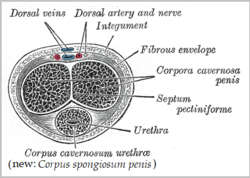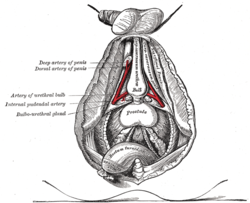Dorsal artery of the penis
| Dorsal artery of the penis | |
|---|---|
 Transverse section of the penis. (Dorsal artery visible at top.) | |
 The deeper branches of the internal pudendal artery. (Dorsal artery of penis labeled at upper right.) | |
| Details | |
| Source | Internal pudendal artery |
| Vein | Deep dorsal vein of the penis |
| Supplies | Penis |
| Identifiers | |
| Latin | arteria dorsalis penis |
| TA98 | A12.2.15.044M |
| TA2 | 4354 |
| FMA | 19795 |
| Anatomical terminology | |
The dorsal artery of the penis is a bilaterally paired terminal branch of the internal pudendal artery which passes upon the dorsum of the penis to the base of the glans penis, where it unites with its contralateral partner and supply the glans and foreskin.
The dorsal artery of the penis provides blood supply to the skin and fascia of the penis (including the foreskin), and the erective tissues of the penis (especially the glans penis).
The dorsal artery of the penis may be damaged in traumatic amputation of the penis and repairing the dorsal artery surgically prevents skin loss, but it is not essential for sexual and urinary function. Its hemodynamics and blood pressure can be assessed to test for sexual impairment.
Structure
[edit]The homologous artery in the female is the dorsal artery of clitoris.[1]
Origin
[edit]The dorsal artery of the penis is a terminal branch of the internal pudendal artery, arising at the inferior border of the symphysis pubis.[1]
Course and relations
[edit]It passes between the crus penis[2] and the pubic symphysis[citation needed] of the pelvis to reach the dorsal surface of the corpus cavernosus penis.[2]
As it pierces the perineal membrane, it (depending upon the source) passes between the two layers of the suspensory ligament of the penis,[citation needed] or pierces the lateral lamina of the suspensory ligament of penis.[1]
It passes distally along the dorsum of the penis to reach the base of the glans penis.[1] In the dorsum of the penis, it passes in between the deep dorsal vein of penis (situated medially to the artery[citation needed]) and dorsal nerve of penis (situated laterally to the artery[citation needed]);[2] it is situated superficial to the deep dorsal vein of penis.[1]
Fate
[edit]At the base of the glans penis, it anastomoses with its contralateral counterpart to form an arterial circle which supplies glans penis and foreskin (prepuce).[1]
Anastomoses
[edit]It sends branches through the fibrous sheath of the corpus cavernosum penis to anastomose with the deep artery of the penis.[citation needed] It anastomoses with the artery of bulb of penis.[3] It terminates by anastomosing with its contralateral partner.[1]
Branches and territory
[edit]The dorsal artery of the penis supplies the skin and fascia of the penis[1][3] including the foreskin (prepuce),[1][3] the corpus cavernosum penis,[1] and the (especially[2]) the glans penis.[1][3][2]
Its superficial collateral branches are distributed to the integuments of the penis.[1] It gives deep/perforating collateral branches to the corpus cavernosum penis[1] (despite this, its contribution to erectile function is inconsistent[citation needed]). Through retrograde flow it helps supply the skin of the distal shaft. It also gives branches to the circumflex arteries that supply the corpus spongiosum.[citation needed]
Additional images
[edit]-
Arteries and veins of the penis (Spanish)
-
The penis in transverse section, showing the blood vessels.
-
Diagram of the arteries of the penis.
-
Cross section of penis
References
[edit]![]() This article incorporates text in the public domain from page 620 of the 20th edition of Gray's Anatomy (1918)
This article incorporates text in the public domain from page 620 of the 20th edition of Gray's Anatomy (1918)
- ^ a b c d e f g h i j k l m "artère dorsale du pénis - Dictionnaire médical de l'Académie de Médecine". www.academie-medecine.fr. Retrieved 2024-05-21.
- ^ a b c d e Sadeghi-Nejad, Hossein; Dogra, Vikram; Seftel, Allen D; Mohamed, Mamdouh A (March 2004). "Priapism". Radiologic Clinics of North America. Emergency Ultrasound. 42 (2): 427–443. doi:10.1016/j.rcl.2004.01.008. ISSN 0033-8389. PMID 15136026.
- ^ a b c d Jacob, S. (2008). "4 - Abdomen". Human Anatomy. Churchill Livingstone. p. 123. doi:10.1016/B978-0-443-10373-5.50007-5. ISBN 978-0-443-10373-5.
External links
[edit]- Anatomy figure: 42:01-01 at Human Anatomy Online, SUNY Downstate Medical Center - "Cross-section of the penis."
- Anatomy image:9477 at the SUNY Downstate Medical Center
- perineum at The Anatomy Lesson by Wesley Norman (Georgetown University) (maleugtriangle4)
- figures/chapter_32/32-2.HTM: Basic Human Anatomy at Dartmouth Medical School
- figures/chapter_32/32-3.HTM: Basic Human Anatomy at Dartmouth Medical School




